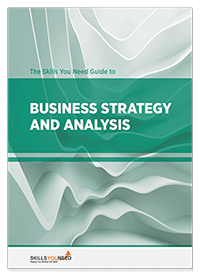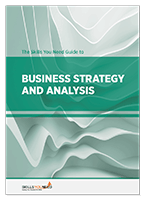Achieving Sustainable Competitive Advantage
See also: PESTLE AnalysisSustainable competitive advantage is an important issue in business. It means having something that gives you an edge over your competitors, and will continue to do so. It can apply to both people and businesses.
For businesses, it means something that your customers see as a long-term reason to buy from you rather than your competitors.
As an individual, you can ensure that you have the skills that mean that employers will continue to want to employ you in the longer term.
This page explores the concept, and provides some ideas for tools that you can use to identify areas where you have an advantage, and then help you to maintain that.
Defining Sustainable Competitive Advantage
A competitive advantage is anything that allows a business to outperform other businesses in the same industry or sector (its competitors). A sustainable competitive advantage is one that lasts in the longer term.
Sustainable competitive advantage can arise from anything that means that your customers are more likely to buy your products or use your services.
For example:
- A new process that enables you to produce something quicker and therefore more cheaply;
- Better customer service, as a result of investing in your staff; or
- A patented invention which only you have free access to use.
Because a sustainable competitive advantage leads to long-term gains over your competition, it is highly sought-after by businesses.
Long-term, not forever
A sustainable competitive advantage is a long-term concept, but will not last forever.
As soon as any company develops one, its competitors will immediately start trying to copy what it does. Once one of them manages to do so, the advantage is gone.
Businesses with a sustainable competitive advantage must therefore continue to innovate, to ensure that they stay ahead.
Identifying Potential Advantages
Two useful tools for identifying your potential competitive advantages are USP analysis and core competences analysis.
- USP analysis identifies your ‘unique selling proposition’, or the thing that only you offer customers that distinguishes you from your competitors.
- Core competence analysis focuses on what the company does really well, and that others do not. Core competences have to be relevant (that is, improve the way you serve your customers), not be possible to imitate (in other words, they must be unique to you), and broad (provide openings to a range of markets and customers).
Both USP analysis and core competence analysis start in the same place: identifying and understanding what customers want and value
This requires you to dig down into what actually makes customers buy particular products or services, and how they make their buying decisions. It is a good idea to involve those in the organisation who have most contact with customers, such as the sales team. It is an even better idea to ask your customers and potential customers.
The end result of this step is a list of criteria that customers use in their decision-making.
USP analysis
Once you have your list of buying criteria, for USP analysis you then need to:
Identify your top competitors
Which firms are competing in the same space as you for this product or service? This may or may not mean companies doing the same thing as you, but alternatives that your customers might consider. Identify the main competitors, usually up to about five organisations.
At this stage, it may be helpful to remember that customers do not usually buy a product for itself, but for the effect it will have.
For example, you buy a drill because you wish to make holes. The competitive alternative to a drill is therefore not a saw, but perhaps a handyman. Your competitors may not be quite what you expect.
Rank yourself and your competitors using these buying criteria
Using a suitable scale (three-, five- or ten-point scales can all work), rank yourself, and your top competitors for each of the buying criteria.
Identify what you do well compared to others
One very good way to do this is to draw a graph, because it makes your similarities and differences very clear. The question you need to answer is:
What do we do better than everyone else?
If there is nothing that distinguishes you, the next step is to look for an area where everyone does badly, and make it your own. In other words, ask:
What could we do better than everyone else? And what would we need to do to achieve this?
Make the necessary improvements and market yourself on that basis
Identifying a suitable area for success is only half the battle.
The next step is to make the necessary improvements (if any), and then market yourself on that basis. For example, if you have identified that your products are more expensive, but much better quality, then it is no good trying to compete on price. Instead, you must emphasise to your customers that the quality you provide is worth the additional cost.
Core competence analysis
Core competence analysis also starts with the list of buying criteria, but the steps that follow are rather different:
Identify the competences or skills that lie behind each buying factor
For example, if customers value low prices, then the competences behind that may include automation, access to cheap components, or an alternative manufacturing process. Try to identify all the possible skills that could affect each factor, not just ones that you already have.
Identify your competences and skills
The next step is to work out what you already do well: what skills do you or the company possess that could or do enable you to deliver what customers want?
At this stage, you should now have a list of your competences and the competences required to deliver for customers.
On both lists, identify any that are core competences
Check each competence against the tests for core competences: relevance, not possible to imitate and broad. You then need to ask two questions:
- Do we already have any of the required core competences?
- If not, could we develop any of them, building on what we can already do?
Hopefully the answer to one or both of these questions is yes, and you can then start to work on the core competences required, either building or strengthening your position.
If the answer to both is no, then you may need to consider an alternative market or environment that will better suit your skills.
It is also worth considering whether you spend a lot of time or energy on something that is not a core competence. If so, you might want to think about outsourcing it.
Further Reading from Skills You Need
The Skills You Need Guide to Business Strategy and Analysis
Based on our popular management and analysis content the Skills You Need Guide to Business Strategy and Analysis is a straightforward and practical guide to business analysis.
This eBook is designed to give you the skills to help you understand your business, your market and your competitors.
It will help you understand why business analysis is important for strategy—and then enable you to use analytical tools effectively to position your business.
Using analysis to develop sustainable competitive advantage
For both businesses and individuals, the key to success is identifying and building on your strengths, and managing your weaknesses. The tools described here enable you to do that, and then build a long-term advantage for yourself or your business.
This page focuses more on using this type of analysis in business, and as a manager or leader. For more about individual development, you may want to read our pages on Personal Development.
As with any analysis, finding the answer is only the start. You then have to put them into practice, and develop the sustainable competitive advantage that will help you to get, and stay, ahead.


